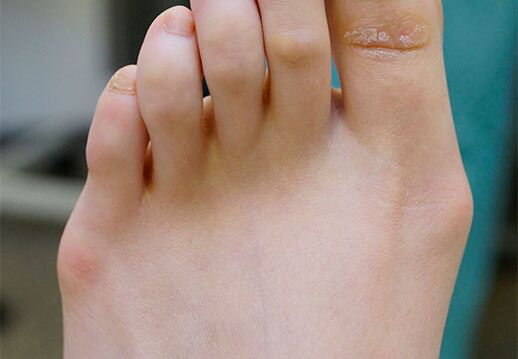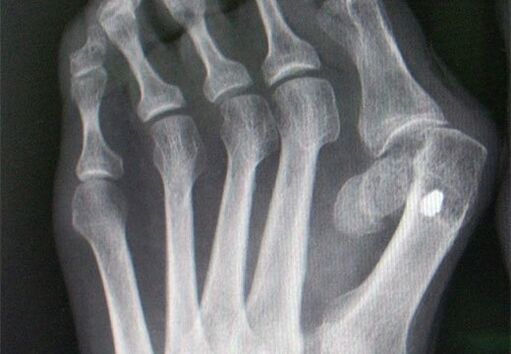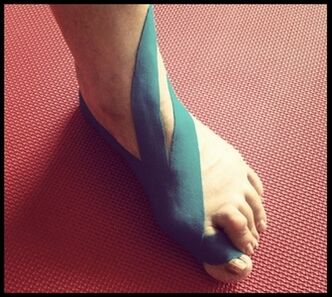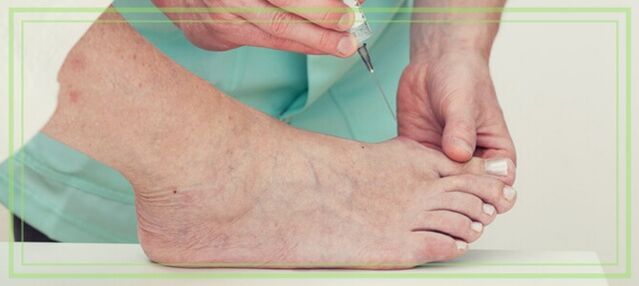Valgus deformation from the toes is the most common orthopedic disease.Its main feature is 1 plusphalx curvature together.In the early stages, it shows itself in the form of small growth near the thumb.Pathology has a slow development, so it is difficult to diagnose it in the early stages.Valgus deformation is often combined with a violation of blood supply to tissues, leading to the development of arthritis or arthrosis.In the absence of treatment in the thumb joints, the acute inflammation process occurs, called Bursite.

What contributes to fingerprints?
The causes of valgus deformation can vary, the main one between them is considered:
- flat feet;
- Congenital pathology of plusplange joints;
- muscle weakness, leading to the pathological mobility of the bone surface;
- foot injuries;
- Destruction of cartilage against arthritis or arthrosis.
Wearing uncomfortable shoes to direct the cause of the disease, but it can accelerate the development of the pathological process.Thus, Khalus Valgus is most often found in women.There are other causes of pathology why the first toe can bend.Osteoporosis develops when calcium soluble from bone tissue, as it becomes less dense.This is what leads to joint shape changes.Almost everyone with the symptoms of Valgus deformation has one of 2 types of flat feet.Endocrine disorders contribute to the decrease in ligaments, which is why they cannot hold the joints in the right position.Risk groups include women who usually walk in high shoes.The preparation of increased load on the toes accelerates the joint curvature process.Ballet dancers have to stand on the socks for a long time, which can cause foot shape.Therefore, Valgus deformation is found in only 3% of people under the age of 30, while among the elderly every 5 people have the same problem.The disease is most often found in patients whose parents have pathology of the musculoskeletal system.

Clinical picture of the disease
The curvature of the toe in the early stages is a bit difficult to observe.Someone realizes that he is uncomfortable to walk in ordinary shoes.After a long stay in the stand, the pain syndrome occurs.Over time, the main sign of the pathology appears - the first metatarsophalangeal joint deviation in the second with the formation of cones.The rest of the fingers take the shape of the hammer.Patients may experience fatigue and chronic difficulties in choosing shoes.Over time, corn appears on the scalp, bringing a lot of difficulties to someone.The most common signs of valgus deformation are painful sensations related to synovial membrane inflammation.A soft seal appears in the first finger.Skin of the affected area and swell.Over time, bone corn is formed, soft irritating and cartilage.Strong pain appears while walking.Joint mobility is limited, the pathological process can cover all the toes.
Some degrees of deformation of valgus are distinguished, each has its own symptoms:
- Hallux Valgus from the first degree is characterized by finger curvature of no more than 20 °.There is no pain at the same time.
- In the case of a 2-degree disease, the joints are transferred 21-30 °.The unpleasant sensation is lightweight, the movement of the finger is not interrupted.
- With the deformation of the valgus at the 3rd level, the curvature angle exceeds 30 °.The pain in the affected area has a continuous character.They prevent someone from wearing ordinary shoes, walking and playing sports.
- In 4 stages of the disease, the joints are transferred more than 50 °.Deformation of this degree is characterized by strong pain, difficulty with shoe choice, corn formation.
How the disease is lowered

To make an early diagnosis, foot examination and history of anamnesis are performed.The doctor should:
- assess the severity of Gait changes;
- Joint curvature levels;
- the presence of corn;
- Bone cones.
The main therapeutic step
The choice of specific methodology depends on the degree of joint deformation and the severity of the pain syndrome.The most effective treatment of valgus deformation from the toes is in the early stages.Therapy can be conservative and surgery.In addition, the development of orthopedic shoes, which contributes to proper load distribution and prevents appearanceCorn, helps suspend the development of pathological processes.To reduce pressure in the affected area, specialty and gaskets.Due to many side effects, these funds are not suitable for prolonged use.Drug therapy cannot save someone from the deformation of the valgus.With its help, you can only eliminate pain and signs of inflammation.For the treatment of this disease, physiotherapy procedures are often used - diathermy or ultrasound.However, this method also brings temporary release.The most effective is the use of orthopedic devices made by taking into account the characteristics of individual feet.The use of supporters and fingers in the early stages of the disease prevents joint deformation.With the advanced form of the disease, orthopedic devices allow you to make walking more comfortable.With the help of special insoles, you can eliminate the leading cause of curvature - flat feet.This operation is usually required for 3-4 degrees of valgus deformation, when conservative treatment is ineffective.The choice of method depends on the degree of severity of the deformation.With a little finger shift, only bone growth is released.To do this, a small slice is made in the affected area, after which the lump is cut and removed.

Distal osteotomy is intended to reduce the angle of curvature.The bottom of the bone is opened and mounted in the correct position.The proximal osteotomy implies the effect on the top of the finger.During Keller's operation - the brand, the thumb joints are completely removed, the remaining synovial shell is placed between the added bone and the main falanx.Surgical intervention is used in most cases of valgus deformation.The effectiveness of treatment largely depends on the accuracy of the implementation of the recovery steps.During the postoperative period, it is necessary to wear solid shoes or use special devices.To reduce the load on the hand -operated leg, you need to use a stick.Shoes should have wide feet and low heels.Keep in mind that any surgical intervention can lead to the development of complications.
The most dangerous ones are:
- soft tissue infections;
- osteomyelitis;
- bleeding;
- displacement of bone fragments;
- delay the healing process;
- Loss of finger sensitivity.
More rare complications are avascular neurosis and post -traumatic arthritis.Prevention of valgus deformation is a continuous visit to orthopedis.Wearing high heels should be rejected.The use of orthopedic insoles is recommended.Long stay in a standing position is prohibited.Valgus deformation is a serious disease that can worsen the quality of life of the patient, so treatment should start in the early stages.

Treatment of Khalus Valgus (Hallux Valgus) without surgery
Excessive weight, wearing uncomfortable shoes, foot trauma leads to the appearance of the pain of the painful thumb, hyperemic protrusion.It's called - Hallux Valgus.What is Hallux Valgus?The term is literally described as follows: Hallux is a thumb, and valgus is a curvature.The protrusion formed is the medial part of the first metatarsal bone.At the same time, it gradually departs from other metatarsal bones, which visually increases size.The disease is characterized by severe pain, it is impossible to wear normal shoes.The skin on the protrusion is always rubbed, inflamed, in cases of rare bleeding.With the circulation of medical aid soon, significant deformation for all metatarsophalangeal joints occurs.The first and second fingers are crossed, the other fingers can bend accidentally, while the extension becomes impossible.
Cause
To better understand what Khalus Valgus is, you need to know the causes and mechanisms of the disease.It grows most often in women, because their ligaments are not as strong as men.Such modifications do not develop independently, the effects of the following pathogenic factors are required for its manifestations:
- Weight gain - in obese people, there is an increase in load in the plusno -flanning joint area, leading to stretching of ligament apparatus, which connects metatarsal bones;
- Narrow, uncomfortable, pressed, in high heels, shoes are the main trigger of the state.Wearing frequent shoes with narrow feet, also on high heels, contributing to persistent changes in the physiological position of the thumb, which is why it gradually deviates;
- Changes in hormone backgrounds, which often occur in fair sex people, contribute to changes in metabolism and connective tissue trophism, which results in increased tendons, damage their integrity;
- Traumatization - significant damage to muscle tendons that perform key functions and move, causing dominance of one of them, which is the cause of the first metatarsal bone deviation;
- Diabetes mellitus - leads to the development of diabetes, characterized by affected blood circulation and muscle trophism, tendons and ligaments, which allow to express itself to deformation;
- Arthritis and toe arthrosis can lead to the development of chronic inflammation, these diseases also stimulate the process of growth of osteophytes that can cause affected joint deformation;
- Pregnancy is a period of life in a woman's life, when complete hormone restructuring occurs, and an increase in stomach transfers the load to the front of the leg, which causes the development of Khalus Valgus.

Hallux Valgus level
The level of Khalus Valgus' gravity is determined based on the angle between the first and second metatarsal bones, as well as the angle of the thumb of the first metatarsal bone.There are three stages of the development of the disease:
- Hallux Valgus of the first degree is characterized by minimal deviations that form: Inter angles -less than 12 degrees, and thumbs do not exceed 25 degrees.At the same time, the patient may not be completely absent in pathognomonic symptoms, and visual changes are almost invisible.
- Khalus Valgus 2 degrees - indicated by an increase in angles - flower angles to 18 degrees, at this point the first finger is rejected more than 25 degrees.With the development of this deformation, painful sensations arise, discomfort when wearing ordinary shoes.With excessive physical overstrain, the pain is increasing.The convex part of the bone head is always rubbed, hyperemic, swelling, which indicates the process of inflammation.
- Hallux valgus 3 degrees is indicated by significant curvature, the angle between the metatarsal bone exceeds 18 degrees, and the first and second fingers are crossed.A significant red bulge is observed on the inside, painful on the palpation.Wearing any shoes is impossible because of the pain, the patient is always drowning, releasing the affected member.
Treatment tactics depend on the neglect of the pathological process.In the first stage, you can do it with a conservative method using tires and other setting devices.The following stages require immediate surgery, without the foot change, unwanted complications will occur.
Valgus' fine treatment method
Before starting treatment, it is necessary to exclude the effects of pathological factors.First of all, you need to lose weight.For this, patients are recommended to play sports, lead an active lifestyle.One important thing is that when doing physical work, it is forbidden to apply power to the affected member.The appointment of diet therapy is an important step in the treatment of Khalus Valgus.Experts can recommend an effective diet, but it should include vitamin and mineral -rich products that will help improve the condition of the affected joints.

Tires and orthopedic fixes
They are used for continuous fixation of defects plus bones and fingers closer to other feet.You can use a hardcore lock - a tire that, when set on the feet, does not allow it to move the finger.Such devices are used during sleep, as well as long rest.You can use the use of silicone silicone.There are silicone providers attached only to the thumb, as well as attaching to all fingers.The main advantage of this development is the ability to walk in the shoes in it.At the same time, effective fixation of the bones is continuous, and the latch itself is not felt when wearing.























